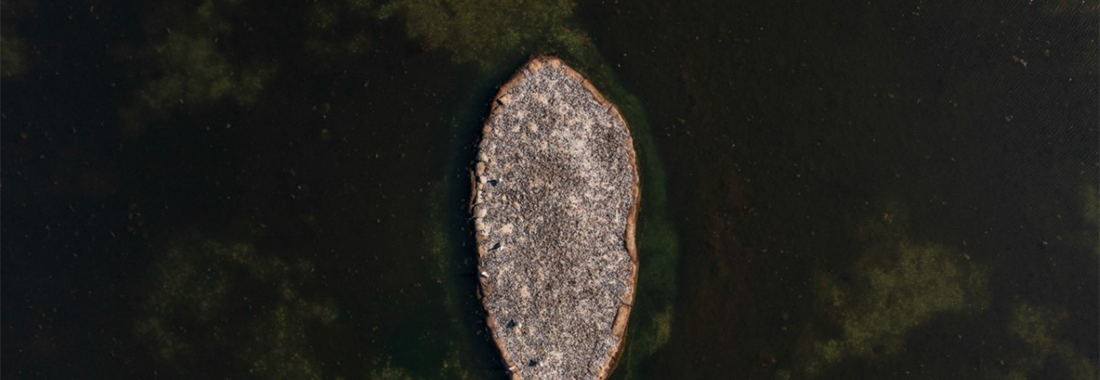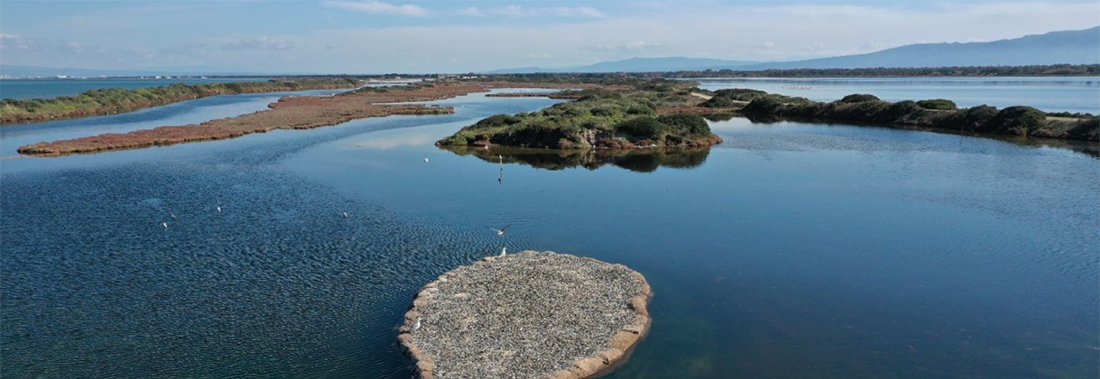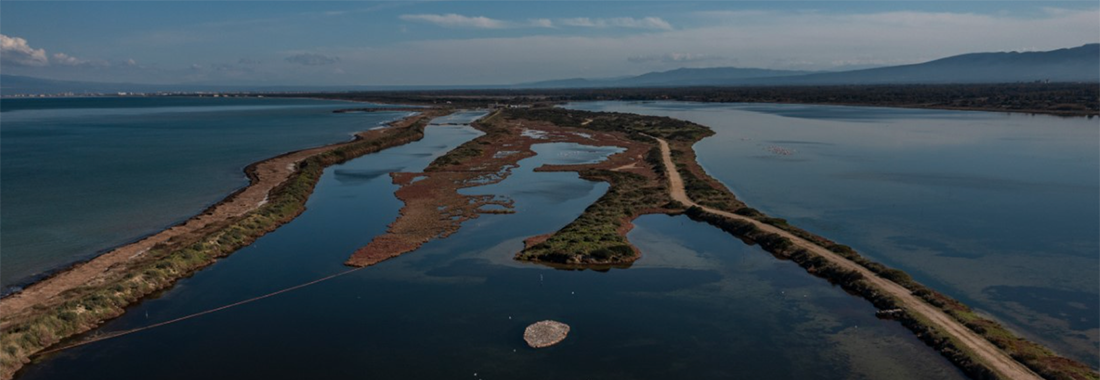Little tern, common tern, sandwich tern, rosy gull and black-winged stilt are some of the bird species that have found a home in Corru Mannu in recent weeks. Thanks to the circular economy project applied to mussel farming - which sees MEDSEA and Nieddittas cooperating in the name of environmental protection at the forefront - the artificial islet made with mussel shells in the wetland in the Gulf of Oristano is populated!
In the name of the "circular economy", a new island made of mussels for migratory birds
This is what the Mediterranean Sea and Cost Foundation (MEDSEA), a non-profit institution that promotes the protection and sustainable development of coastal ecosystems, and Nieddittas, the brand that manages the entire mussel farming chain in the Gulf of Oristano, have placed at the core of the project on the reuse of mussel shells for the construction of an artificial islet at the Corru Mannu pond (Ramsar site of Corru S'Ittiri, ponds of San Giovanni and Marceddì).
Supporting the establishment and nesting of some bird species is the objective of the initiative born within Maristanis, an international cooperation project for the protection and integrated management of the coastal wetlands of the Gulf of Oristano.
The islet has an ovoid shape, it is about 20 metres long, 7 metres wide and 2 metres high, i.e. about 50 cm above average sea level and is therefore almost completely immersed in water. It is made up of 2000 jute sacks full of mussel shells (deriving from the Nieddittas processing) manually positioned with the help of a boat, which allowed the materials to be transported to the place of construction, and the support in the water of two divers who they coordinated the positioning activities at about 50 metres from the mainland. In the area where the Nieddittas establishments are located, to which the Sardinia Region has entrusted the protection and safeguarding of the site, the artificial island enjoys an extremely favourable position for nesting, wintering and migration of important species of aquatic birds and migratory species.
The space inside the embankment was further filled with mussel shell waste, stratified and gradually compacted to make the surface stable and walkable. The surface layer of the islet consists of a mixed layer of crushed shells, mussels and fine linen to make the surface welcoming for future guests of the islet. Furthermore, following the results of the monitoring, the silhouettes of birds will be positioned, if necessary, which will be able to attract other species to the land for nesting.
Why an artificial island in Corru Mannu, Oristano?
Corru Mannu, a highly valuable wetland, was already included in the list of wetland areas of international importance in the 1970s, drawn up on the basis of the Ramsar convention. On the basis of the community directive "Habitat" n. 92/43/EEC and "Birds" no. 79/409/EEC was declared a site of Community interest and a special protection area and consequently included in the Natura 2000 network, a system of areas dedicated to the conservation of biodiversity, characterised by the presence of habitats and species of fauna and flora of high interest. In recent weeks, the islet, as hoped, has begun to host the nesting of the Little Tern (Sternula albifrons), of the Common Tern (Sterna hirundo), of the Sandwich Tern (Thalasseus sandvicensis), of the Rosy Gull (Chroicocephalus genei) and of the Cavaliere d' Italy (Himantopus himantopus).
The innovation introduced by Nieddittas differs from similar experiments, already tested in Italy and Sardinia, for the material that is used, i.e. the shells of mussels, capable of absorbing carbon dioxide and which therefore can be considered a net carbon sink . Therefore, solutions based on nature (Nature-based-Solution) are being tested in the protected area of Corru Mannu. Recent approach used by the European Commission to identify nature-based strategies, actions, interventions that provide environmental services and socio-economic benefits capable of increasing the resilience of the environment. What happens in this case where the islets are areas naturally protected from the predation of feral or stray wild or domestic animals; the distance from the bank allows the passage of vehicles and working personnel without disturbing the delicate nesting phase; the ease of screening on the road adjacent to the closest bank facilitates observations and control of the structures; the use of the project for dissemination and environmental education actions, nominating the area as a real outdoor naturalistic laboratory.
The islet, precisely because of its distance from the mainland, does not allow "access to terrestrial and/or stray predators (such as cats, rats or dogs...) explains Alessio Satta, president of the MEDSEA foundation - and "can be adapted and promoted in other wetlands», through the use of waste – free of contaminants, such as mussel shells without the edible part – for the construction of nesting areas or environmental restoration.
Latest news

ARTEMIS: Marine Reforestation Activities Begin in Northern Sardinia
Marine reforestation efforts under the European Interreg Euro-MED “ARTEMIS” project have officially begun off the northern coast of Sardinia, in Santa Teresa Gallura.

REST-COAST: Strategies for the Protection of European Coasts Outlined in Catania
From March 24 to 27, 2025, the annual meeting of the European project REST-COAST, funded by the Horizon 2020 program, was held in Catania. The meeting marked a key milestone toward the…

A Forest for Bees Takes Root in Sardinia: Restoring Nature, Supporting Pollinators
The planting operations for the first Forest for Bees installation—a forest for bees—have been completed in Sennariolo (OR). This is a special one-hectare forest dedicated to bees and pollinators, essential insects for food…

Altare Hosts RICREA Meeting: Shared Strategies Through Ecological Transition Contracts
The third Steering Committee of the RICREA project – Collaborative Network for the Capitalization of REtrAlags – was held in Altare (Savona). The project is funded by the Italy–France Maritime Interreg Programme.

GRRinPORT2: Innovation and Cross-Border Cooperation for Environmental Protection of Ports
On March 20–21, 2025, the Kickoff Meeting of the GRRinPORT2 project – Management of water, waste, and sediments to reduce pollution in ports – was held at the DESTEC Department of the University of Pisa…

MEDSEA Launches the Wetland4Change Project in Terralba to test and validate climate change's solutions
On Friday, March 14, 2025, in the council chamber of Terralba, MEDSEA held a meeting with the Municipality of Terralba to officially introduce Wetland4Change to stakeholders (productive activities, as well as institutional…

In Crete with ARTEMIS to protect seagrass meadows: 2nd Consortium Meeting
From March 4th to 6th, 2025, Heraklion (Crete) hosted the mid-term meeting of the ARTEMIS Interreg Euro-MED Natural Heritage project, organized by the Hellenic Marine Research Centre. This was a crucial moment to…

MEDSEA Heads to Tallinn for the Blue4All Consortium Meeting
Last January, the Blue4All project team gathered in Tallinn for the Consortium Meeting, marking the project's halfway point. The event, hosted by the local partner Keskkonnaamet/Estonian Environmental Board and the University of Tartu, brought together all 22 project partners from across…

ImPelaghiamoci: A Year of Initiatives to Learn About and Protect Cetaceans with the Municipality of Sassari
Promoting greater knowledge of the resident cetaceans in the Pelagos Sanctuary*, a transboundary marine protected area encompassing France, Liguria, Tuscany, and Sardinia, to improve the protection and conservation of these species…

Reforestation Operations Resume in Montiferru: A Forest for Bees by MEDSEA
Reforestation efforts in Montiferru, led by MEDSEA, are back on track. Following the planting of the first 5 hectares of olive trees, holm oaks, and Mediterranean shrubs, the focus now shifts to melliferous plants to…

25 Events in Sardinia for World Wetlands Day
Wetlands such as ponds, lagoons, lakes, rivers, and peatlands form an endless world of aquatic ecosystems. In Sardinia, the call to explore these habitats is open this February with the Sardinian edition of World Wetlands Day.

COASTRUST: Launching Sustainable Coastal Management in Domus de Maria Sardinia
The activities of the COASTRUST project, funded by the European Interreg Euro-MED program, have officially begun in Sardinia. The initiative aims to promote shared environmental management in the Mediterranean's coastal areas, addressing anthropogenic pressures…

Join the World Wetlands Day Sardinia 2025 Calendar: register your Event by January, 22nd
World Wetlands Day is celebrated every year on February 2, marking the adoption of the Convention on Wetlands signed on February 2, 1971, in Ramsar, on the shores of the…

MEDSEA joins the Camargue Red Alert with the Mediterranean Alliance for Wetlands to save birdlife
The MEDSEA Foundation has officially joined 73 other international organizations in signing the Camargue Red Alert, a collective call to action to safeguard the Camargue wetlands in France.

Wetland4Change: MEDSEA in Valencia to Explore Natural Climate Solutions Through Wetlands
The MEDSEA team participated in the second Consortium meeting of the Wetland4Change project in Valencia from November 26 to 28, 2024. The meeting was organized by local project partners, the…

Malta’s First Posidonia Meadow Restoration Project Led by MEDSEA Foundation
Different islands, but similar issues for marine ecosystems, which are heavily threatened by unregulated anchoring from recreational boating and illegal trawling. In Malta, as in Sardinia, the damage is particularly…
- 1
- 2
- 3
- 4




